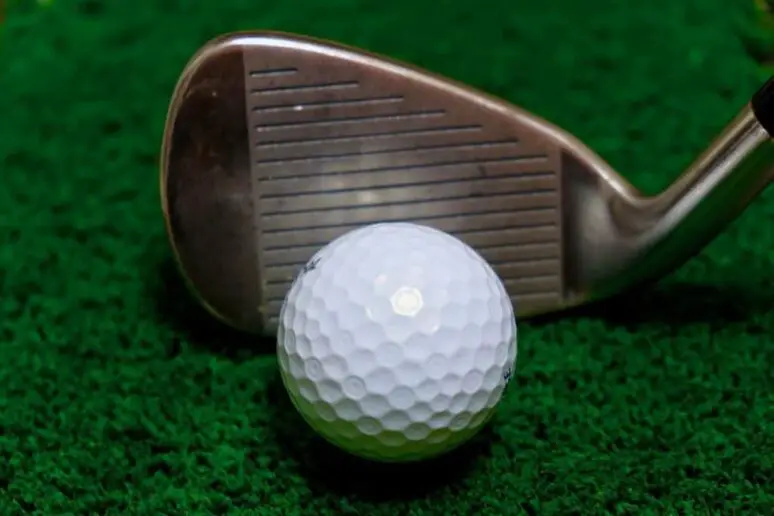Are Groove Sharpeners Legal? (Solved!)
A good golf club can have a positive impact on your shot and improve your overall game.
However, this is true only if the club is in good condition.
After prolonged use, golf clubs, especially irons, start to wear down.
This is particularly noticeable on the grooves which become blunt over time, making the clubface a bit duller.
Because of this, the ball doesn’t grip the clubface the way it should, hindering your ability to properly hit the shot.
This is also the reason why you always see caddies cleaning the clubface after every shot.
However, worn-down grooves don’t mean that you have to buy a new iron. Instead, you can quickly fix the grooves by using the groove sharpeners.
This is a common practice among golfers and is done on all levels of the game. Still, some players avoid doing this as they’re not sure are groove sharpeners legal.
Table of Contents
What Is A Groove Sharpener?
Before moving on to exploring whether the groove sharpener is legal, we should first clarify what it actually is.
A groove sharpener is a narrow metal wedge designed so it can fit into the clubface groove and refine the metal the groove is made of.
So, it does exactly what you would’ve guessed from its name.
The sharpening process involves moving the sharpener back and forth within the groove.
In the process, the sharpener will begin to refine and sharpen the barriers of grooves, which provides a better grip on the ball on the hit.
In addition to sharpening the grooves, the groove sharpener also works to clean out any dirt that has built up between the grooves over time.
Plus, the tool shaves off the older layer of metal from the surface of the grooves, making them look crispy and new.
Are Groove Sharpeners Legal?
No products found.
Groove sharpeners are perfectly legal and there’s nothing in the rules of either USGA or R&A, the world’s main golf governing organizations, that says otherwise.
However, while groove sharpeners themselves and their use are under no restrictions, you have to be extra careful when using them and ensure that the modification to the groove will not break any regulations.
The width, depth, symmetry, spacing, and consistency of clubface grooves have to be up to standard.
If you, in the process of sharpening, alter them so they fall outside these parameters, your club will be deemed illegal for use.
This makes sharpening a rather tricky business, as most manufacturers design grooves to be just inside these standards, so any tinkering can put them over the line.
You should also be aware that groove sharpening is not allowed in the middle of the round as any mid-round equipment modifications are strictly forbidden.
USGA and R&A Groove Rules
As already mentioned, USGA and R&A have set the standards on how the clubface groove is supposed to be designed and how it should look like.
If you plan to use a groove sharpener make sure that you’re familiar with these rules, so you won’t unintentionally make your club illegal.
According to the USGA and R&A rulebook, the width of the groove can not exceed 0.035 inches.
Furthermore, the maximum groove’s depth is set at 0.020 inches and the spacing between adjacent grooves must be at least 0.075 inches.
In addition, the space between grooves must be equal to or greater than 3 times the width of each groove.
Additional rules that apply only to clubs with 25+ degrees of loft also say that grooves must be straight and parallel and have a symmetrical cross-section.
Finally, groove sides mustn’t converge and their edges should have a minimum radius of 0.10 inches,
What are the Benefits of Using a Groove Sharpener?

Sharpening the grooves using this tool will clean them up nicely, increase the grip on the ball, and positively impact the club’s performance.
Still, you shouldn’t expect miracles or drastic changes in the way the club performs. Sharper grooves won’t increase the distance on your shots or deliver more consistency.
However, as they improve grip on the ball, crisp and sharp grooves will provide more spin.
This is why, as you probably know, drivers and fairway woods don’t have grooves on their clubfaces, as spin is not much of a factor in situations when you use these clubs.
On the other hand, irons, and wedges have them because extra spin here can help you hold more greens.
More spin also provides more control over shots, higher ball elevation, especially when using higher-numbered irons, and reduces the wind impact on the ball flight path.
How Often Should Grooves be Sharpened?
Groove sharpening shouldn’t be done too often as it will increase the chance of overdoing it and bringing the grooves outside the standard.
Therefore, you should use a groove sharpener only when the grooves are dull to a pin that they create significantly less friction and grip between the club and the ball.
Most likely, you will play hundreds of rounds before this happens. Still, you should be on the lookout for signs that your clubface grooves need sharpening.
The first sign is slight discoloration of the area where most balls are hit.
If you notice this, use a pencil, golf tee, or your nail and run them along the groove edges. If they run smoothly, there’s still no need for sharpening.
Also, visually check if some of the groove edges are turned down and covering the original groove. If this is the case, it may be time for sharpening.
Conclusion
Sharp clubface grooves are necessary for the irons and wedges to provide optimal performance and help you play your optimal game.
However, as you use your clubs, the grooves will at some point become too dull to grip the ball properly, so, you’ll need to sharpen them.
Doing this with a groove sharpener is rather easy and perfectly legal.
Nevertheless, while the sharpening process itself is fairly simple, it does require some experience, as it’s easy to go too far and damage the grooves, making your clubs illegal.
Therefore, if you plan to use a groove sharpener, make sure to do it carefully and with the utmost attention.
If you’re not comfortable with this, then it may be better to take your club to the local golf club repair shop.




